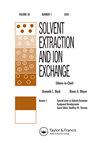沸石从模拟高放废液中选择性分离Zr(IV
IF 2.1
4区 化学
Q3 CHEMISTRY, MULTIDISCIPLINARY
引用次数: 0
摘要
摘要从强酸和强放射性溶液中有效分离Zr(IV)对乏燃料后处理厂至关重要,但这仍然是一项具有挑战性的任务。本研究以沸石为吸附剂,研究了Zr(IV)在HNO3溶液中的吸附。用X射线衍射(XRD)、扫描电子显微镜(SEM)、透射电子显微镜(TEM)和X射线光电子能谱(XPS)对沸石进行了表征。研究了吸附时间、HNO3浓度、Zr(IV)的初始浓度、沸石用量和温度对Zr(Ⅳ)吸附行为的影响。结果表明,HY沸石对Zr(IV)的吸附能力高于H-SSZ-13沸石。HY沸石的吸附容量受其Si/Al比的影响,Si/Al比值决定了吸附位点的密度。最佳HY沸石(HY-25)的最大吸附量为30.438 mg/g,3 M HNO3溶液。此外,还研究了Zr(IV)的吸附等温线和吸附动力学。根据Freundlich等温线模型和拟二阶动力学模型,Zr(IV)在沸石上的吸附是吸热和自发的。在Zr(IV)和10种共存阳离子(Ag+、Ba2+、Cs+、Ce3+、Eu3+、Fe3+、La3+、Nd3+、Sm3+、Sr2+)的模拟强酸溶液中,HY-25对Zr(Ⅳ)表现出良好的选择性吸附,表明其在高放射性废液处理中具有潜在的应用前景。本文章由计算机程序翻译,如有差异,请以英文原文为准。
Selective Separation of Zr(IV) from Simulated High-Level Liquid Wastes by Zeolites
ABSTRACT Effectively separating Zr(IV) from strong acidic and radioactive solutions is crucial for spent fuel reprocessing plants, but it remains a challenging task. This study investigated the adsorption of Zr(IV) in HNO3 solutions using zeolites as adsorbents. The zeolites were characterized by X-ray diffraction (XRD),scanning electron microscopy (SEM), transmission electron microscopy (TEM) and X-ray photoelectron spectroscopy (XPS). The effects of adsorption time, HNO3 concentration, the initial concentration of Zr(IV), zeolites dosage, and temperature on the Zr(IV) adsorption behaviors were investigated. The results demonstrated that HY zeolite had a higher adsorption capacity for Zr(IV) than H-SSZ-13 zeolite. The adsorption capacity of HY zeolite was influenced by its Si/Al ratio, which determined the density of adsorption sites. The optimal HY zeolite (HY-25) exhibited a maximum adsorption capacity of 30.438 mg/g in 3 M HNO3 solution. Furthermore, the adsorption isotherms and kinetics of Zr(IV) adsorption were investigated. The adsorption of Zr(IV) on zeolites was endothermic and spontaneous, in accordance with the Freundlich’s isotherm model and pseudo-second-order kinetic model. In a simulated strong acidic solution of Zr(IV) and 10 co-existing cations (Ag+, Ba2+, Cs+, Ce3+, Eu3+, Fe3+, La3+, Nd3+, Sm3+, Sr2+), HY-25 exhibited good selective adsorption of Zr(IV), indicating its potential application in the treatment of high-level radioactive liquid waste.
求助全文
通过发布文献求助,成功后即可免费获取论文全文。
去求助
来源期刊
CiteScore
4.40
自引率
5.00%
发文量
15
审稿时长
8.4 months
期刊介绍:
Solvent Extraction and Ion Exchange is an international journal that publishes original research papers, reviews, and notes that address all aspects of solvent extraction, ion exchange, and closely related methods involving, for example, liquid membranes, extraction chromatography, supercritical fluids, ionic liquids, microfluidics, and adsorption. We welcome submissions that look at: The underlying principles in solvent extraction and ion exchange; Solvent extraction and ion exchange process development; New materials or reagents, their syntheses and properties; Computational methods of molecular design and simulation; Advances in equipment, fluid dynamics, and engineering; Interfacial phenomena, kinetics, and coalescence; Spectroscopic and diffraction analysis of structure and dynamics; Host-guest chemistry, ion receptors, and molecular recognition.

 求助内容:
求助内容: 应助结果提醒方式:
应助结果提醒方式:


